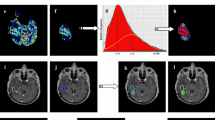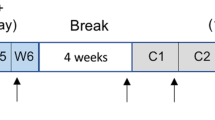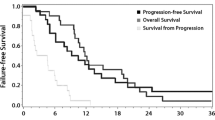Abstract
We previously showed that the farnesyl transferase inihibitor, Tipifarnib induced vascularization normalization, oxygenation and radiosensitization in a pre-clinical glioblastoma (GBM) model. The aim of this study was to assess by dynamic-susceptibility-contrast MRI (DSC-MRI) the effect of radiotherapy (RT) and Tipifarnib combination on tumor perfusion in GBM patients. Eighteen patients with newly diagnosed GBM, enrolled in a phase I-II clinical trial associating RT with Tipifarnib, underwent anatomical MR imaging and DSC-MRI before (M0) and two months after treatment (M2). Anatomic volumes of interest (VOIs) were delineated according to contrast-enhanced and hyper-intense signal areas on T1-Gd and T2 images, respectively. Perfusion variations between M0 and M2 were assessed with median relative cerebral blood volume (rCBV) inside these VOIs. Another voxel by voxel analysis of CBV values classified 405,117 tumor voxels into High_, Normal_ and Low_CBVTUMOR according to the distribution of CBV in the contralateral normal tissue. These three categories of CBVTUMOR voxels were color-coded over anatomical MRI. Variations of median rCBV were significantly different for two groups of patients (P < 0.013): rCBV decreased when initial rCBV was ≥ 1.0 (Group_rCBV_M0 > 1) and rCBV increased when initial rCBV was < 1.0 (Group_rCBV_M0 < 1). Mapping of color-coded voxels provided additional spatial and quantitative information about tumor perfusion: Group_rCBV_M0 > 1 presented a significant decrease of High_CBVTUMOR volume (P = 0.015) simultaneously with a significant increase of Normal_CBVTUMOR volume (P = 0.009) after treatment. Group_rCBV_M0 < 1 presented a decrease of Low_CBVTUMOR volume with an increase of Normal_ and High_CBV TUMOR volume after treatment. Pre and post-treatment CBV measurements with DSC-MRI characterized tumor perfusion evolution in GBM patients treated with RT combined to Tipifarnib; showing variations in favour of tumor perfusion normalization in agreement with our pre-clinical results of vascular normalization.





Similar content being viewed by others
Explore related subjects
Discover the latest articles and news from researchers in related subjects, suggested using machine learning.References
Stupp R, Mason WP, van den Bent MJ et al (2005) Radiotherapy plus concomitant and adjuvant temozolomide for glioblastoma. N Engl J Med 352:987–996
McDonald MW, Shu H-KG, Curran WJ, Crocker IR (2011) Pattern of failure after limited margin radiotherapy and temozolomide for glioblastoma. Int J Radiat Oncol Biol Phys 79:130–136
Delmas C, End D, Rochaix P, Favre G, Toulas C, Cohen-Jonathan Moyal E (2003) The farnesyltransferase inhibitor R115777 reduces hypoxia and matrix metalloproteinase 2 expression in human glioma xenograft. Clin Cancer Res 9:6062–6068
Monferran S, Skuli N, Delmas C, Favre G, Bonnet J, Cohen-Jonathan-Moyal E, Toulas C (2008) Alphavbeta3 and alphavbeta5 integrins control glioma cell response to ionising radiation through ILK and RhoB. Int J Cancer 123:357–364
Skuli N, Monferran S, Delmas C, Lajoie-Mazenc I, Favre G, Toulas C, Cohen-Jonathan-Moyal E (2006) Activation of RhoB by hypoxia controls hypoxia-inducible factor-1alpha stabilization through glycogen synthase kinase-3 in U87 glioblastoma cells. Cancer Res 66:482–489
Skuli N, Monferran S, Delmas C, Favre G, Bonnet J, Toulas C, Cohen-Jonathan Moyal E (2009) Alphavbeta3/alphavbeta5 integrins-FAK-RhoB: a novel pathway for hypoxia regulation in glioblastoma. Cancer Res 69:3308–3316
Batchelor TT, Sorensen AG, di Tomaso E et al (2007) AZD2171, a pan-VEGF receptor tyrosine kinase inhibitor, normalizes tumor vasculature and alleviates edema in glioblastoma patients. Cancer Cell 11:83–95
Sorensen AG, Emblem KE, Polaskova P et al (2012) Increased survival of glioblastoma patients who respond to antiangiogenic therapy with elevated blood perfusion. Cancer Res 72:402–407
Jain R, Poisson L, Narang J, Scarpace L, Rosenblum ML, Rempel S, Mikkelsen T (2012) Correlation of perfusion parameters with genes related to angiogenesis regulation in glioblastoma: a feasibility study. AJNR Am J Neuroradiol 33:1343–1348
Essock-Burns E, Lupo JM, Cha S, Polley M, Butowski NA, Chang SM, Nelson SJ (2011) Assessment of perfusion MRI-derived patients with newly diagnosed glioblastoma. Neuro Oncol 13:119–131
Batchelor TT, Gerstner ER, Emblem KE et al (2013) Improved tumor oxygenation and survival in glioblastoma patients who show increased blood perfusion after cediranib and chemoradiation. Proc Natl Acad Sci USA 110:19059–19064
Ader I, Delmas C, Bonnet J, Rochaix P, Favre G, Toulas C, Cohen-Jonathan-Moyal E (2003) Inhibition of Rho pathways induces radiosensitization and oxygenation in human glioblastoma xenografts. Oncogene 22:8861–8869
Lanvin O, Monferran S, Delmas C, Couderc B, Toulas C, Cohen-Jonathan-Moyal E (2013) Radiation-induced mitotic cell death and glioblastoma radioresistance: a new regulating pathway controlled by integrin-linked kinase, hypoxia-inducible factor 1 alpha and survivin in U87 cells. Eur J Cancer 49:2884–2891
Moyal Cohen-Jonathan E, Laprie A, Delannes M et al (2007) Phase I trial of tipifarnib (R115777) concurrent with radiotherapy in patients with glioblastoma multiforme. Int J Radiat Oncol Biol Phys 68:1396–1401
Laprie A, Catalaa I, Cassol E, McKnight TR, Berchery D, Marre D, Bachaud J-M, Berry I, Cohen-Jonathan Moyal E (2008) Proton magnetic resonance spectroscopic imaging in newly diagnosed glioblastoma: predictive value for the site of postradiotherapy relapse in a prospective longitudinal study. Int J Radiat Oncol Biol Phys 70:773–781
Ducassou A, Uro-Coste E, Verrelle P et al (2013) αvβ3 Integrin and Fibroblast growth factor receptor 1 (FGFR1): prognostic factors in a phase I-II clinical trial associating continuous administration of Tipifarnib with radiotherapy for patients with newly diagnosed glioblastoma. Eur J Cancer 49:2161–2169
Tensaouti F, Lotterie JA (2008) Sysiphe-Neuroimaging Software Toolbox. European Society for Magnetic Resonance Medicine and Biology 2008 Congress Oct 2–4, Val. p Software exhibits
Li X, Tian J, Li E, Wang X, Dai J, Ai L (2003) Adaptive total linear least square method for quantification of mean transit time in brain perfusion MRI. Magn Reson Imaging 21:503–510
Lemasson B, Chenevert TL, Lawrence TS et al (2013) Impact of perfusion map analysis on early survival prediction accuracy in glioma patients. Transl Oncol 6:766–774
Saraswathy S, Crawford FW, Lamborn KR, Pirzkall A, Chang S, Cha S, Nelson SJ (2009) Evaluation of MR markers that predict survival in patients with newly diagnosed GBM prior to adjuvant therapy. J Neurooncol 91:69–81
Leimgruber A, Ostermann S, Yeon E, Buff E, Maeder P, Stupp R, Meuli R (2006) Perfusion and diffusion MRI of glioblastoma progression in a four-year prospective temozolomide clinical trial. Int J Radiat Oncol Biol Phys 64:869–875
Wen PY, Macdonald DR, Reardon DA et al (2010) Updated response assessment criteria for high-grade gliomas: response assessment in neuro-oncology working group. J Clin Oncol 28:1963–1972
Chang SM, Nelson S, Vandenberg S et al (2009) Integration of preoperative anatomic and metabolic physiologic imaging of newly diagnosed glioma. J Neurooncol 92:401–415
Catalaa I, Henry R, Dillon WP, Graves EE, McKnight TR, Lu Y, Vigneron DB, Nelson SJ (2006) Perfusion, diffusion and spectroscopy values in newly diagnosed cerebral gliomas. NMR Biomed 19:463–475
Crawford FW, Khayal IS, McGue C, Saraswathy S, Pirzkall A, Cha S, Lamborn KR, Chang SM, Berger MS, Nelson SJ (2009) Relationship of pre-surgery metabolic and physiological MR imaging parameters to survival for patients with untreated GBM. J Neurooncol 91:337–351
Ken S, Vieillevigne L, Franceries X et al (2013) Integration method of 3D MR spectroscopy into treatment planning system for glioblastoma IMRT dose painting with integrated simultaneous boost. Radiat Oncol 8:1
Deviers A, Ken S, Filleron T et al (2014) Evaluation of the Lactate-to-N-Acetyl-aspartate ratio defined with magnetic resonance spectroscopic imaging before radiation therapy as a new predictive marker of the site of relapse in patients with glioblastoma multiforme. Int J Radiat Oncol Biol Phys 90:385–393
Kioi M, Vogel H, Schultz G, Hoffman RM, Harsh GR, Brown JM (2010) Inhibition of vasculogenesis, but not angiogenesis, prevents the recurrence of glioblastoma after irradiation in mice. J Clin Invest 120:674–705
Delmas C, Heliez C, Cohen-Jonathan Moyal E, End D, Bonnet J, Favre G, Toulas C (2002) Farnesyltransferase inhibitor, R115777, reverses the resistance of human glioma cell lines to ionizing radiation. Int J Cancer 100:43–48
Weller M, Stupp R, Hegi ME, Van Den Bent M, Tonn JC, Sanson M, Wick W, Reifenberger G (2012) Personalized care in neuro-oncology coming of age: why we need MGMT and 1p/19q testing for malignant glioma patients in clinical practice. Neuro Oncol 14:100–108
Jain R, Poisson LM, Gutman D et al (2014) Outcome prediction in patients with glioblastoma by using imaging, clinical and genomic biomarkers: focus on the nonenhancing component of the tumor. Radiology 272:484–493
Stupp R, Hegi ME, Gorlia T et al (2014) Cilengitide combined with standard treatment for patients with newly diagnosed glioblastoma with methylated MGMT promoter (CENTRIC EORTC 26071-22072 study): a multicentre, randomised, open-label, phase 3 trial. Lancet Oncol. doi:10.1016/S1470-2045(14)70379-1
Weller M, Yung WKA (2013) Angiogenesis inhibition for glioblastoma at the edge: beyond AVAGlio and RTOG 0825. Neuro Oncol 15:971
Chinot OL, Wick W, Mason W et al (2014) Bevacizumab plus radiotherapy-temozolomide for newly diagnosed glioblastoma. N Engl J Med 370:709–722
Gilbert MR, Dignam JJ, Armstrong TS et al (2014) A randomized trial of bevacizumab for newly diagnosed glioblastoma. N Engl J Med 370:699–708
Just N (2014) Improving tumour heterogeneity MRI assessment with histograms. Br J Cancer 111:2205–2213
Tunariu N, Kaye SB, Desouza NM (2012) Functional imaging: what evidence is there for its utility in clinical trials of targeted therapies? Br J Cancer 106:619–628
Acknowledgments
The authors thank Benjamin Rowland (Brigham and Women’s Hospital, Radiology Department, Boston, MA, USA) for proofreading the manuscript.
Author information
Authors and Affiliations
Corresponding author
Additional information
Elizabeth Cohen-Jonathan Moyal and Anne Laprie are co-last authors and have contributed equally to this work.
Rights and permissions
About this article
Cite this article
Ken, S., Deviers, A., Filleron, T. et al. Voxel-based evidence of perfusion normalization in glioblastoma patients included in a phase I–II trial of radiotherapy/tipifarnib combination. J Neurooncol 124, 465–473 (2015). https://doi.org/10.1007/s11060-015-1860-8
Received:
Accepted:
Published:
Issue Date:
DOI: https://doi.org/10.1007/s11060-015-1860-8
Keywords
Profiles
- Soléakhéna Ken View author profile
- Patrice Péran View author profile




